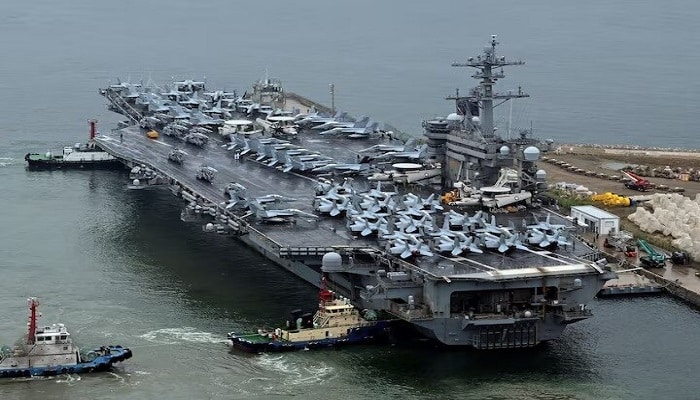PNN – Experts and security observers believe that the era of aircraft carriers, through which the United States was able to strike fear among its rivals over the past decades, is nearing its end.
According to the report of Pakistan News Network, Al Jazeera News Agency, in an article referring to the latest tensions in the international arena, addressed the lack of efficiency of aircraft carriers in the world and wrote: The aircraft carrier Gerald R. Ford is described as a “floating city” and is one of the newest and most advanced aircraft carriers in the United States.
This ship was commissioned in 2017, during Donald Trump’s first term as president, and is considered the most advanced aircraft carrier in the world, weighing over 100,000 tons. Many analysts see the ship as a symbol of the power of the US Navy. Aircraft carriers, as mobile airports capable of carrying and flying dozens of fighter jets, have long been a symbol of American dominance over international waters.
Al Jazeera adds that the spread of long-range offensive weapons technology has exposed floating cities, which have cost billions of dollars to produce, to attack from hypersonic missiles, anti-ship missiles, and cheap drones. This has led US Defense Secretary Pete Hegsett to speculate about the value of these ships. In an interview last November, he stated that 15 hypersonic missiles could sink 10 US aircraft carriers in 20 minutes.
Hegsett’s comments are a confirmation of the dangers facing the large, expensive ships that were once America’s national pride. Many military analysts point to these developments and believe that the era of aircraft carriers, through which the United States was able to strike fear among its rivals in previous decades, is nearing its end.
Read more:
Iran is ready for a stronger and more severe response to the Zionist regime.
Yemen a threat to American ships
The United States has the largest fleet of aircraft carriers in the world, with 11 large ships, all of which are nuclear-powered. Other countries in the world have a total of 11 of these ships, most of which are European countries such as the United Kingdom, France and Spain, or US allies such as Japan.
One of the US aircraft carriers is the Gerald Ford, which is stationed in the Pacific Ocean, the Atlantic Ocean, the Mediterranean Sea, and the Persian Gulf. Through these ships, the US is trying to pursue freedom of navigation and global trade to its advantage. Gerald Ford ships are expensive to produce; costing $13 billion each, while $4.7 billion is spent on scientific and technical studies to produce them, and their use is also expensive.
The Gerald R. Ford took over 10 years to build, and since it has nuclear power plants inside, it can stay at sea for 20 years without refueling. The ship has 25 floors, is 335 meters long, and can carry 80 combat aircraft. The ship has an active crew of 5,000.
Last April, Yahya Saree announced the attack on the US aircraft carrier Harry Truman. Although the US Air Force announced that the ship would continue its operations after the attack, the US changed the position of its ships to protect itself from Yemeni missile attacks. Of course, American ships had been attacked by Yemeni forces before, but they had survived these attacks.
Hypersonic missiles have retired aircraft carriers.
The United States currently lacks a defense system capable of intercepting and destroying advanced hypersonic missiles. The Dongfeng 27 missile, a Chinese-made missile designed to attack ships, was unveiled in 2021.
This missile is a ballistic missile capable of carrying a warhead that can be detached from the missile body and attack the target at supersonic speeds. The missile’s range is estimated to be between 5,000 and 8,000 kilometers, and it is capable of flying at low altitudes and changing direction suddenly, which makes it difficult to target.
Assault boats, the killer of American ships
Small, unmanned attack boats are another threat to these ships. In a 2005 simulation off the coast of California, a small, inexpensive Swedish submarine successfully simulated sinking the USS Ronald Reagan.
Drones: The Cheap Enemy of American Ships
Drones are another threat to aircraft carriers and have managed to shift the balance of power in many regional wars and conflicts in recent years. For this reason, many countries have moved towards investing in the production of drones. These drones come in several types, including reconnaissance drones, combat drones, and suicide drones. They are very cheap, and for this reason, they have become a common weapon among countries.
Available reports indicate that two cheap drone strikes can completely disable or even sink an aircraft carrier. BBC expert and journalist Jonathan Head, referring to this report, expressed doubts about the effectiveness of aircraft carriers, saying that these ships could be sunk in a matter of minutes with weapons worth less than a few thousand dollars.
Michael O’Hanlon, director of the Brookings Institution’s Foreign Policy Program Studies, examined US defense spending in August 2021 and expressed doubts about the future of large American carriers and their ability to withstand growing threats. In an article on this subject, former US Army Special Forces officer Steve Ballistri considered the era of aircraft carriers to be over and raised the question: if one of these ships were to sink, what would happen to the approximately 80 or 90 fighter jets on board?

